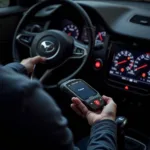The world of automotive diagnostics can seem complex, especially with acronyms like DLC3 and OBD2 floating around. If you’re looking to demystify these terms and understand how they relate to keeping your vehicle running smoothly, you’ve come to the right place. This article will break down the differences between a DLC3 connector and OBD2, explore their individual functions, and shed light on how they work together.
Decoding the Jargon: DLC3 and OBD2 Explained
Before diving into the differences, let’s clarify what each term represents:
-
DLC3 Connector: DLC stands for Data Link Connector. The ‘3’ signifies the third iteration of this connector, often found in heavier-duty vehicles like trucks and buses. It serves as a physical access point for diagnostic tools to communicate with a vehicle’s electronic control units (ECUs).
-
OBD2: On-Board Diagnostics, version 2, is a standardized system implemented in most cars and light trucks manufactured after 1996 in the United States (1994 for some European vehicles). It mandates a universal connector (typically a 16-pin trapezoidal port) and a standardized communication protocol for retrieving vehicle diagnostic information.
 DLC3 and OBD2 Connectors
DLC3 and OBD2 Connectors
Key Distinctions: Why Are There Different Connectors?
The main reason for different connectors boils down to the complexity and specific needs of various vehicle types:
-
Heavy-Duty Demands: DLC3 connectors, often found in heavy-duty vehicles, cater to the more robust electrical systems and diverse electronic controls found in these vehicles. The connector type and communication protocols might differ from the standard OBD2 to accommodate a wider range of data transmission requirements.
-
Standardization for Passenger Vehicles: OBD2, on the other hand, aimed to standardize diagnostics for passenger cars and light trucks. By unifying the connector type and communication protocols, OBD2 made it easier for mechanics and vehicle owners to access diagnostic information regardless of the make or model.
The Connection: How DLC3 and OBD2 Work Together
While DLC3 and OBD2 might appear distinct, they share a common goal: providing access to vehicle diagnostic data.
Think of the DLC3 connector as the gateway and OBD2 as the language spoken.
-
In heavy-duty vehicles with a DLC3 connector, you would use a specialized adapter cable that connects to the DLC3 port and converts the communication protocol to the standard OBD2 format.
-
This conversion allows OBD2 scanners and diagnostic tools to understand the data transmitted by the vehicle’s ECUs, even though it doesn’t have a traditional OBD2 connector.
FAQs: Common Questions About DLC3 and OBD2
1. Can I use a regular OBD2 scanner on a vehicle with a DLC3 connector?
Directly, no. You’ll need a DLC3 to OBD2 adapter cable to connect your OBD2 scanner.
2. Are all heavy-duty vehicles equipped with a DLC3 connector?
While common, it’s best to consult your vehicle’s manual or a trusted mechanic to confirm the type of diagnostic connector.
3. Does the adapter cable affect the accuracy of the diagnostic information?
A high-quality adapter cable should not impact the accuracy. Ensure you choose a reputable brand known for reliable connections.
Need Further Assistance?
If you’re looking for the right diagnostic tools or need help navigating the world of DLC3 and OBD2, don’t hesitate to reach out! Contact our team of experts via WhatsApp at +1(641)206-8880 or email us at [email protected]. We’re available 24/7 to assist you.

